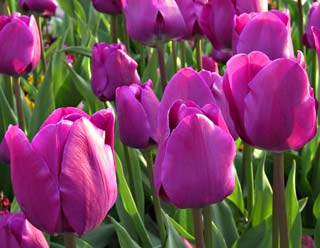Why know spring flowers?
A 1.5 m tall scavenger plant in Brooklyn blossomed for the first time in the past week, giving off a frightening smell that lasts for 3 days. Luckily for Dutch tulip growers, this flower only blooms in the spring and has a much sweeter fragrance.

Dutch tulips (Photo: smugmug.com)
The flowering plants were born about 100 million years ago. When the earth's climate changes, some plant species have developed strategies to submerge themselves in the winter and bloom in the spring. These plants will not bloom until they feel the winter is over. That process is called springing.
Scientists have only just begun to understand how flowering plants know spring has come.
Plants will not bloom in the fall because then some genes are activated to overwhelm flowering activities. But when enough of the cold days passed, those genes would be turned off and the green light turned on to prepare to burst.
For plants, blooming before the spring equinox can also cause death . So accuracy is very important. Flowers need not only a thermometer-like tool to measure outside temperatures, but they need to count the full winter months.
The secret to winter tracking is not just stopping in the plant kingdom. Insects also measure cold days so they don't lay eggs too early in the year.
While the length of winter refers to when the flower opens its first wing, the hourly activity of the flower depends on the length of the day.
In 1920, researchers began planting flowers under artificial light. Experiments show that plants only bloom when they recognize the right time of daylight.

Scavenger tree (Photo: Livescience)
MT
- The secret to keeping fresh flowers long during Tet holidays
- Spring petals: precious medicine
- Typical flowers of spring
- Purple flowers in the North West between the spring of Hanoi
- Silly at the beauty of
- 10 types of flowers often plugged in the family of the North of New Year
- Spring is full of flowers in Phu Tang
- The beauty of flowers and spring rice fields in the northwest
- How to grow and care vy wing flowers
- Listed 7 species of 'most smelly' flowers in the world
- Spring in the Department of Astronomy
- An odd episode in spring
 Why do potatoes have eyes?
Why do potatoes have eyes? 'Tragedy' the world's largest carnivorous life: Death becomes ... public toilet
'Tragedy' the world's largest carnivorous life: Death becomes ... public toilet Tomatoes were once considered 'poisonous' for 200 years
Tomatoes were once considered 'poisonous' for 200 years Detecting microscopic parasites on human face
Detecting microscopic parasites on human face